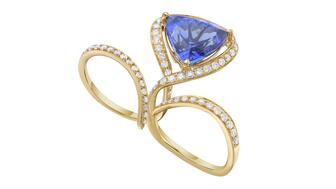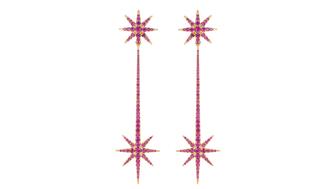Diamond Companies Sanctioned, Dealer Charged With Money Laundering
Officials allege a “complex network” of entities helped Nazem Said Ahmad deal in diamonds and artwork in the U.S. despite being sanctioned.

Announced Tuesday, the sanctions encompass 52 individuals and companies OFAC said helped Nazem Said Ahmad evade U.S. sanctions and launder money in order to fund Hezbollah and his “luxurious lifestyle.”
Lebanon-based Hezbollah, also spelled Hizballah, is an Iran-backed political party and militant group believed to be responsible for numerous terrorist attacks.
It has been designated by the U.S. as a Foreign Terrorist Organization since 1997, and a Specially Designated Global Terrorist since October 2001.
Ahmad, a diamond and art dealer with both Lebanese and Belgian citizenship, has been on OFAC’s Specially Designated Nationals list since December 2019 for allegedly laundering money and evading taxes.
The 52 entities designated in this latest round of sanctions—which OFAC described as a “complex network” of Ahmad’s family members, business associates and companies spread across eight countries—used shell companies and fraudulent schemes to disguise the sanctioned Ahmad’s role in financial transactions involving diamonds and works of art, which he frequently shares on his Instagram page.
OFAC said Ahmad’s network took advantage of the “permissive nature” of the global diamond, gemstone, and art markets to buy and move around luxury goods.
It also mentioned the Kimberley Process specifically, noting that Ahmad’s network allegedly coerced both “witting and unwitting” participants into creating fake KP certificates to manipulate diamond prices and taxes and make their businesses look legitimate.
The full list of sanctioned companies and individuals is available on the OFAC website and includes diamond companies based in South Africa, the Democratic Republic of Congo, Antwerp, and Dubai.
The sanctions bar people and companies in the U.S. from doing business with any of the named entities as well as any entities that are owned, directly or indirectly, 50 percent or more by one or more blocked persons.
In an alert sent to members Thursday afternoon, Jewelers Vigilance Committee CEO and General Counsel Tiffany Stevens and Deputy General Counsel Sara Yood recommended U.S. businesses with automated OFAC software run their customer and supplier lists through their software program to ensure they’re not doing business with any sanctioned entities.
For companies doing manual checks, Stevens and Yood said they should cross-check the OFAC list against their lists of suppliers and customers.
Businesses without compliant anti-money laundering (AML) programs can find more information about implementing one on the JVC website.
The Treasury Department announced the sanctions the same day federal prosecutors in Brooklyn, New York, unsealed an indictment charging Ahmad and eight others with orchestrating a “long-standing” scheme to evade U.S. sanctions, defraud the U.S. and foreign governments, and launder money.
According to the 50-plus-page indictment, filed under seal March 29, after the U.S. sanctioned Ahmad in December 2019, entities controlled by him or operating for his benefit made more than $400 million in financial transactions, importing $207 million worth of goods into the U.S. and exporting more than $234 million, all the while hiding the fact that Ahmad was involved.
Those imports and exports consisted primarily of diamonds and artwork, the indictment states.
For diamonds specifically, the indictment noted the defendants worked together to utilize grading services from a U.S.-based diamond grading company, identified in court documents only as “Diamond Grading Company-1” with a facility in New York.
The services were secured through multiple entities operating for Ahmad’s benefit and were valuable to all parties because the “cut, color and clarity grades assigned by the company, as well as the certification of the stone’s carat weight, affected the price at which a diamond could be sold.”
All told, the defendants and other conspirators submitted 482 diamonds to the lab after Ahmad was sanctioned in December 2019, totaling about 1,546 carats with a value of more than $91 million, the indictment states.
The U.S. Attorney’s Office for the Eastern District of New York is handling the prosecution, as goods were shipped in and out of New York’s John F. Kennedy Airport in Queens.
As of Tuesday, the office said one person had been arrested in connection with the scheme—The New York Times reported it was Ahmad’s accountant, who was arrested in Britain—while the others, including Ahmad, reside outside the U.S. and remain at large.
The Latest

Carlos Jose Hernandez and Joshua Zuazo were sentenced to life without the possibility of parole in the 2024 murder of Hussein “Sam” Murray.

The New Orleans jeweler is also hosting pop-up jewelry boutiques in New York City and Dallas.

Set in a Tiffany & Co. necklace, it sold for $4.2 million, the highest price and price per carat paid for a Paraíba tourmaline at auction.

How Jewelers of America’s 20 Under 40 are leading to ensure a brighter future for the jewelry industry.

The jeweler’s “Deep Freeze” display showcases its iconic jewelry designs frozen in a vintage icebox.


Take luxury gifting to new heights this holiday season with the jeweler’s showstopping 12-carat sphene ring.

This year's theme is “Unveiling the Depths of the Ocean.”

Roseco’s 704-page catalog showcases new lab-grown diamonds, findings, tools & more—available in print or interactive digital editions.

In its annual report, Pinterest noted an increase in searches for brooches, heirloom jewelry, and ‘80s luxury.

Starting Jan. 1, customers can request the service for opal, peridot, and demantoid garnet.

The 111-year-old retailer celebrated the opening of its new location in Salem, New Hampshire, which is its third store in the state.

The new catalog features its most popular chains as well as new styles.

The filmmaker’s personal F.P. Journe “FFC” prototype was the star of Phillips’ recent record-setting watch auction in New York.

The new location in the Design District pays homage to Miami’s Art Deco heritage and its connection to the ocean.

Inflations, tariffs, and politics—including the government shutdown—were among consumers’ top concerns last month.

“Longtime favorite” presenters, as well as first-time speakers, will lead talks and workshops at the annual event in Tucson next year.

Silas Smith of Meridian Metalworks won the challenge with his pendant that blends Australian and American landscapes.

The sale of the 31.68-carat, sunset-hued stone was part of Sotheby’s first series of events and auctions in Abu Dhabi.

Most customers who walk into your store this month have made up their minds. Your job is to validate their choice, Emmanuel Raheb writes.

The collection features characters and motifs from Ukrainian folklore, including an enchanted mirror and a magic egg.

MatrixGold 3.11, the newest version of the jewelry design program, offers more flexibility, precision, and creative control.

The pavilion will be part of the 2026 JA New York Spring show, scheduled for March 15 to 17.

Kadet, a 1994 National Jeweler Retailer Hall of Fame inductee, helped grow the family-owned retailer in the Chicago area and beyond.

Billed as the world’s smallest wearable, Lumia Health’s new smart earrings have a health tracker subtly embedded in the back.

Don’t let those with December birthdays feel blue. Help them celebrate their month with blue zircon, turquoise, and tanzanite.

The new pink sapphire version of the piece dances with its wearer in the brand’s “Icons After Dark” holiday campaign.

A choice that’s generated a lot of commentary, Pantone says “Cloud Dancer” marks a fresh start and encourages relaxation and creativity.




























